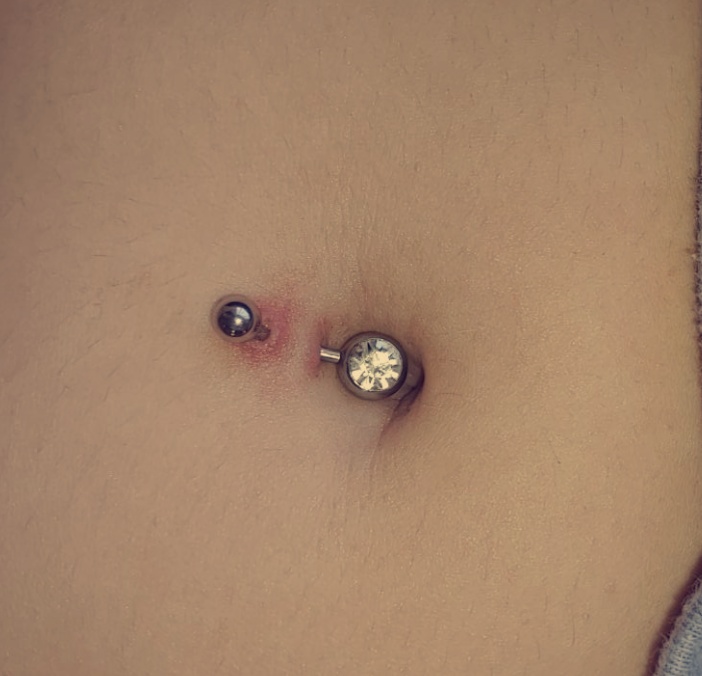Are you worried your piercing might be rejecting? Are you worried about getting your next piercing because of that risk?
We often get asked about rejection. It can absolutely happen but it’s not as common as you may think.
Let’s talk about how it happens, why it happens and what it will look like when it does.
It’s important to remember that no matter what piercing you get you are putting a foreign object in your body. Our bodies are designed to fight foreign objects, be it a virus or a splinter, even organ transplants can fail due to rejection.
When you get a new piercing, your body is going to do one of two things. It can encapsulate the piercing, allowing it to heal and creating a fistula around the jewelry allowing for a permanent pathway or it can push the jewelry out of the skin. The best is example is a splinter. If you leave it in your finger, you’ll notice over time your body will slowly push it out. That’s the general definition of rejection. When your body literally pushes the jewelry out of its location. The risk of rejection is possible with any piercing but it’s much more common for surface piercings or areas with extremely soft tissue.
Surface piercings, microdermals, navels, eyebrows genuinely run the highest risk because they are all technically surface piercings. It’s not as common for oral piercings or ear piercings but depending on the actual piercing is still a possibility.
What to look for:
It’s pretty common for everyone to come to their own conclusions when it comes to their piercings. Unfortunately, it’s common that what you assume is the issue is usually not. Infection is the perfect example. Redness and swelling are often mistaken for infection. Irritation bumps are also typically not a sign of rejection. A good sign that your piercing is rejecting is you’ll notice the tissue over the jewelry getting thinner and thinner. If the edges of the wound have a V shape instead of a C shape that’s also a sign. Just having a bump or some redness doesn’t mean it’s rejecting.
Irritation and bumps can come from a very long list of possible variables. improper placement, Low quality jewelry, snagging, catching, improper aftercare, your cat, your laundry detergent. It’s endless. We typically start at the most common issues and use the process of elimination to sort out why your piercing isn’t happy. We highly recommend if you have any concern what so ever to seek out professional help.
Migration vs rejection:
Essentially these are the same things. Your body is migrating the jewelry to the surface, once that process is over your piercing has rejected. The skin is basically gone, there will be an unsightly scar, the chances of piercing that area again are very slim.
In some cases, piercings can migrate slightly and then stop and you’ll have a happy healthy piercing. If you notice your piercing is starting to migrate, seek professional help immediately. Sometimes your piercing can be saved. If it’s advised that you remove the jewelry, we highly recommend you take that advice. Early detection can prevent a lot of unnecessary damage and scaring.
Causes:
There are a lot of factors that can start this process. The most common is typically a lack enough tissue to support the piercing. Something being too shallow for example. It’s pretty common practice that Piercers will turn away a piercing because of a client’s anatomy. It’s hard to hear and often people think we just don’t want to do the piercing, but we aren’t in the habit of turning away money. If we tell you it’s not a good idea it’s genuinely because we care about you as a client and want you to have a happy and healthy piercing. Navels are usually at the top of this list. If the piercing isn’t done properly or you don’t have the anatomy to support it there’s a really good chance it will reject and you’ll be left with a nasty scar for life.
Improper jewelry: Wearing jewelry that doesn’t fit your anatomy can be absolutely devastating to a piercing even if it’s been healed for years. If you’re not sure what you need seek out help. That’s why we are here!!!!
Low quality jewelry: So, your local mall has a deal where you can get 5 shiny new pieces for $10. That’s awesome. We love saving money too. But is it worth your piercing? Even a healed piercing can flare up and become agitated if the jewelry quality is not right. Again, healed or not these are foreign objects in your body. You don’t want to take a chance that your body will have any kind of reaction be it a new piercing or an old piercing.
Pregnancy: Your body goes through a ridiculous number of changes during a pregnancy. It’s not uncommon for a piercing that is 20 years old to flare up. It’s most common we see issues with navels and nipples but it’s not unheard of that even a simple ear piercing can become problematic. Problem is you’re growing a new life, so your body is on full alert. Anything can be seen as a threat!
Tearing and snagging: This can particularly damage to a well-established piercing. If you tear the fistula or snag it hard enough to kick start the healing process over again you can find yourself in some trouble. Pulling a nipple piercing on a towel. Rolling over and catching your eyebrow on your partners hair. Things happen. If you somehow manage to damage a piercing it’s best to see a professional to access the damage.
Temporary piercings: Not all piercings will be with you for life. Some people get lucky and beat the odds but surface piercings and microdermals are a good example of temporary. These piercings require extra attention and care. There’s a lot of success stories where people have them for years and years with no issue you must treat them with respect through out the entirety of their lifetime! One little snag on a fully healed surface anchor (microdermal) can start that rejection process rather quickly!
Prevention:
At the end of the day, it’s a team effort. It’s up to your piercer to provide you with a properly located piercing with good quality jewelry. Once you leave the shop it’s up to you to maintain it! Proper aftercare and following instructions are key. Days… Months even years after the initial piercing!
Rejection is a very valid concern when getting a piercing and everyone should be aware of the risks. Just keep in mind with a skilled piercer, proper jewelry and proper handling and after care it’s often preventable!

